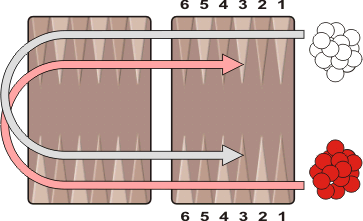![[Backgammon Galore!]](/gif/GaloreButton.gif)
|
|
Backgammon Variants Setup: Each player starts with fifteen checkers off the board. The players enter their checkers in the opponent's home board, then bring them around the board as shown in the diagram below.
Object: The object of the game is to move all of your checkers around the board to your own home table and then bear them off. The first player to bear off all of his checkers wins the game. To start: Each player rolls one die and the higher number goes first. That player then rolls both dice again to begin his first turn. Entering checkers: You enter a checker by placing it on a point in the opponent's home board corresponding to a number rolled. For example, if you roll 6-3, then you enter one checker on the opponent's six-point and one checker on his three-point. Once you have entered one or more checkers, you may use subsequent rolls to move those checkers forward, to enter more checkers, or both. Movement: The roll of the dice indicates how many points, or pips, the player is to move his checkers. The following rules apply:
Acey-deucey: The roll of 1 and 2 (acey-deucey) is especially valuable. When you roll 1-2, this is what happens:
Note, however, if you are unable to use any part of your roll, you forfeit the rest of your turn. For example, if you can move your 2 but cannot use the 1, you may not name a double and you may not roll again. It is permissible to name a double even if only part of it can be used. For example, after moving 1 and 2, you can name 6-6 as your double even if only three of the 6s can be played. You would then lose the fourth 6, and you wouldn't get to roll again. Hitting: A checker sitting alone on a point is called a blot. If an opposing checker lands on a blot, the blot is hit and placed on the bar. Entering from the bar: Any time you have one or more checkers on the bar, your first obligation is to reenter those checker(s) into the opponent's home board. You reenter a checker by moving it to an open point corresponding to one of the numbers on the rolled dice. If you are able to enter some but not all of your checkers on the bar, you must enter as many as you can then give up the remainder of your turn. Bearing Off: Once you have moved all fifteen of your checkers into your home board, you may begin bearing off. You bear off a checker by rolling a number that corresponds to the point on which it resides, then removing the checker from the board. If there is no checker on the point indicated by the roll, you must make a legal move using a checker on a higher-numbered point. If there are no checkers on higher-numbered points, you must remove a checker from the highest point that has a checker. Scoring: The loser pays one point for each of his checkers still on the board (or yet to be entered). Gammons and backgammons do not count extra. The doubling cube is not used in acey-deucey. Strategy: Because the roll of 1-2 is so powerful, luck plays a greater part in acey-deucey than in regular backgammon. You are never completely out of a game. On the other hand, since you start with fifteen men back, there is some added opportunity for skill in placing your checkers to block the opponent. Typical strategy is to get at least half your checkers on the board as quickly as possible and form them into a blockade.
ReferencesBooks
World Wide Web
|
![]()
Backgammon Galore : Variants

